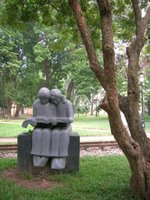Vietnamese oddities

1. Hats. The Vietnamese are a uniquely hat wearing nation. The conical hat seen in films appears to be a woman's hat, which is a pity, because I did want to go around wearing one. Men tend to make do with dark green pith helmets, or baseball caps. Outdoors, about 70% of the population seems to wear one sort of hat or another.
2. Small chairs. Street food is usually the best way to eat in South East Asia; you look for a place with lots of locals sitting eating, see if it smells nice, and, if so, it's probably the best food around. We've had many nice dishes this way - mostly variations of noodle soup or fried rice. But in Vietnam, the street vendors make do with chairs that are ridiculously too small. We have sat many times and ate soup perched on seats no larger than a small pile of paperback novels.
3. Street shops. There seems to be no law designating certain places as licensed for trade, and banning it in others. People who have shops have certain advantages, such as being out of the rain, and being able to lock up, but all over Vietnam entrepreneurs are opening shops in whatever space presents itself. A walk down the pavement and you can come across a man cooking bacon on a wire mesh over a small burner, a woman in a chair with a crate of beer, and a scooter repair shop. These are my favorite, as they are obviously semi-permanent places, only without walls or roof. There can be several scooters parked up, people waiting, and three or four mechanics covered in oil, with engine parts spread over the pavement.
4. Drive-up. As befits a nation of scooter drivers, a large amount of shopping seems to be done from the comfort of the vehicle. Want some shampoo? Well pull onto the pavement, drive along to a shop you fancy, and call across for them to bring it out to you.
5. The Lambada. For some reason, this tune is everwhere. Radios, horns, entrance bells. I have no idea why.
6. Censorship. As far as I can tell, the Vietnamese government has taken the attitude of "blogs, no thanks". So I can post to my blog, edit the pages, but not view it, or any other blog. Anything with a blogspot in it gets the infamous server not found error. Looking on the web, it appears that China also takes this approach.
7. Football. The universal language. We were in a family restaurant the other day, with fine chinese food, but all around us people were glued to the Vietnam vs Japan match. No matter how little english people speak they all seem to have heard of Manchester United, and Wayne Rooney (pronounced Wayn-e Wooney). But then the second thing they say (and I've had this several times now) is that they, themselves are an Arsenal fan!
8. Driving. There are very few cars or lorries on the roads, but scooters everywhere. Some of the more major intersections are controlled by police, or traffic lights, though these seem to be optional, as those in a hurry simply transfer to the pavement. In general, though, intersections are completely unregulated, and traffic seems to advance much the same way that people cross the road - keep to a regular speed, and let everyone else flow around you. It seems to work, though I have noticed cars causing difficulties here, because they are much less manouverable compared to the width of the road.

9. Overloaded Scooters. As the major transport vehicle is the scooter, there is a tendency to load them up for each journey. You can often see two parents and a young (4 year old?) child all on one scooter, and sometimes a family of 4 can be seen driving along. They are also used to carry burdens, including baskets of chickens, planks of wood, boxes, flowers, and bottles of water, which I have seen strapped to the back, sides, and placed between the feet. The most impressive two things I have ever seen carried on a scooter, though, was a pig in one case, and a young cow in another.
 10. Soft yellow walls. Mainly due to the colonial architecture brought in by the French, and the slow decay of these buildings in the years since independence, the predominant colour of the walls and buildings in Vietnam is a flaking, old, mustard yellow. This makes the whole city of Hanoi, for example, seem golden and aged, and adds a lot of charm.
10. Soft yellow walls. Mainly due to the colonial architecture brought in by the French, and the slow decay of these buildings in the years since independence, the predominant colour of the walls and buildings in Vietnam is a flaking, old, mustard yellow. This makes the whole city of Hanoi, for example, seem golden and aged, and adds a lot of charm.






















